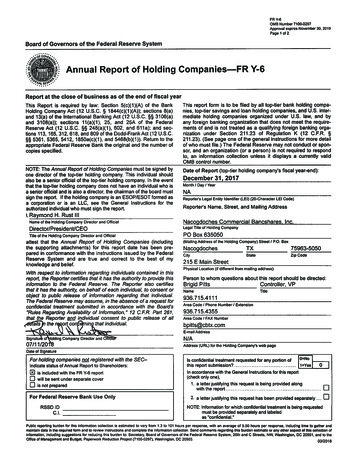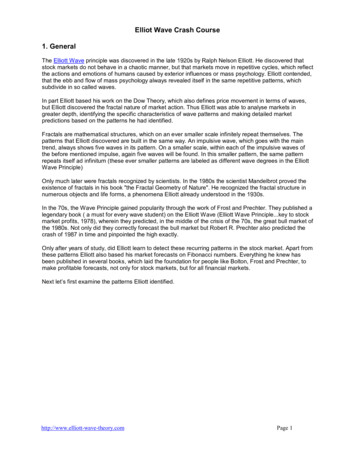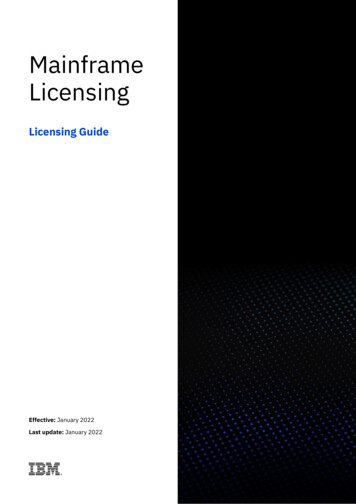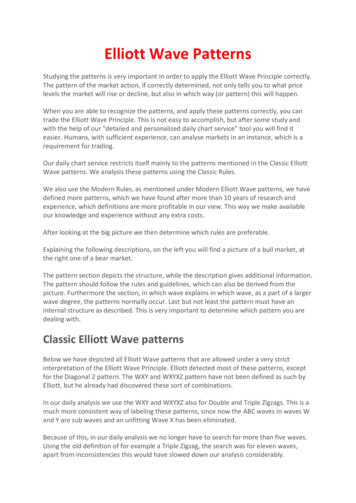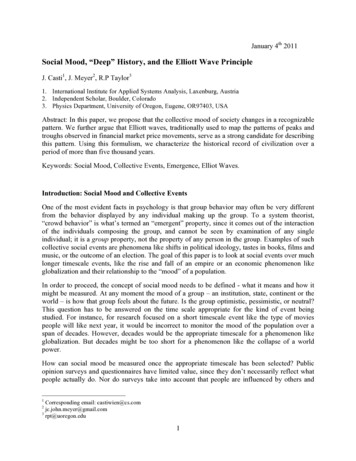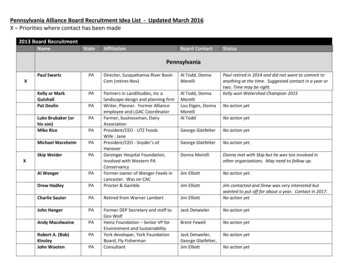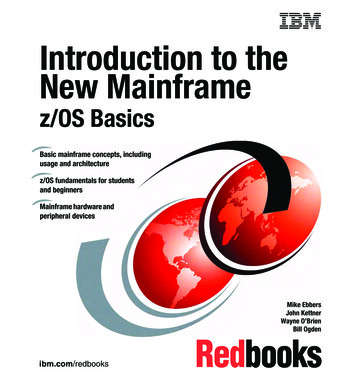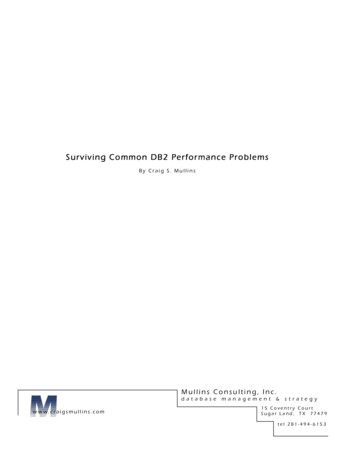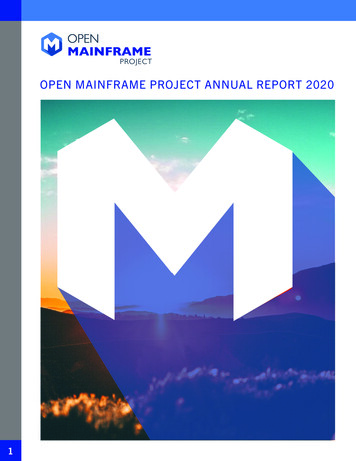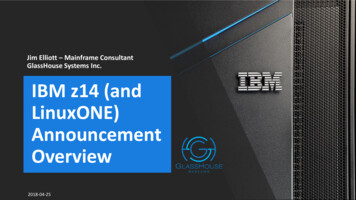
Transcription
Jim Elliott – Mainframe ConsultantGlassHouse Systems Inc.IBM z14 (andLinuxONE)AnnouncementOverview2018-04-25
Trademarks and noticesThe following are trademarks of the International Business Machines Corporation in the United States and/or other countries.Db2*DFSMSdssDFSMShsmECKDFICON*Flash SystemsGDPS*HiperSocketsHyperSwap*IBM*IBM (logo)*ibm.comIBM Z*LinuxONELinuxONE Emperor IILinuxONE Rockhopper IIPower SystemsPR/SMStorwize*System kz/OS*z/VM*z/VSE** Registered trademarks of IBM CorporationLinux is a registered trademark of Linus Torvalds in the United States, other countries, or both.Java and all Java-based trademarks and logos are trademarks or registered trademarks of Oracle and/or its affiliates.UNIX is a registered trademark of The Open Group in the United States and other countries.Other product and service names might be trademarks of IBM or other companies.Notes:Performance is in Internal Throughput Rate (ITR) ratio based on measurements and projections using standard IBM benchmarks in a controlled environment. The actual throughputthat any user will experience will vary depending upon considerations such as the amount of multiprogramming in the user's job stream, the I/O configuration, the storageconfiguration, and the workload processed. Therefore, no assurance can be given that an individual user will achieve throughput improvements equivalent to the performanceratios stated here.IBM hardware products are manufactured from new parts, or new and serviceable used parts. Regardless, our warranty terms apply.All customer examples cited or described in this presentation are presented as illustrations of the manner in which some customers have used IBM products and the results theymay have achieved. Actual environmental costs and performance characteristics will vary depending on individual customer configurations and conditions.This publication was produced in the United States. IBM may not offer the products, services or features discussed in this document in other countries, and the information may besubject to change without notice. Consult your local IBM business contact for information on the product or services available in your area.All statements regarding IBM's future direction and intent are subject to change or withdrawal without notice, and represent goals and objectives only.Information about non-IBM products is obtained from the manufacturers of those products or their published announcements. IBM has not tested those products and cannotconfirm the performance, compatibility, or any other claims related to non-IBM products. Questions on the capabilities of non-IBM products should be addressed to the suppliersof those products.Prices subject to change without notice. Contact your IBM representative or Business Partner for the most current pricing in your geography.This information provides only general descriptions of the types and portions of workloads that are eligible for execution on Specialty Engines (e.g, zIIPs, zAAPs, and IFLs) ("SEs").IBM authorizes customers to use IBM SE only to execute the processing of Eligible Workloads of specific Programs expressly authorized by IBM as specified in the “Authorized UseTable for IBM Machines” provided at www.ibm.com/systems/support/machine warranties/machine code/aut.html (“AUT”). No other workload processing is authorized forexecution on an SE. IBM offers SE at a lower price than General Processors/Central Processors because customers are authorized to use SEs only to process certain types and/oramounts of workloads as specified by IBM in the AUT.GlassHouse SystemsNew IBM z14 and LinuxONE Announcement Overview for CMG2018-04-25Page 2
IBM z14 – Designed for trusted digital experiences Pervasive encryption making data yournew perimeter New flexible software pricing offeringfor modern digital workloads Machine learning applied directly to yourmost valuable data Open and connected with new economicsin the cloud Blockchain on IBM Z where trust meetstransparencyGlassHouse SystemsNew IBM z14 and LinuxONE Announcement Overview for CMGIBM z14Machine Type: 3906Models: M01, M02, M03, M04, M05ModelCustomer PUsMax MemoryM0517032 TiBM0414132 TiBM0310524 TiBM026916 TiBM01338 TiB2018-04-25Page 3
Extending the IBM z14 familyBuilt on the sameIBM z14 technologyGlassHouse SystemsAddressing new marketsStandardization andSimplicityNew IBM z14 and LinuxONE Announcement Overview for CMGOne strong platform andfamily for the future2018-04-25Page 4
IBM z14 Model ZR1 – Built for digital trust, secure cloud Platform simplification‒ Standardization across many components – includingIndustry standard 19” rack‒ 16U free space in frame Processor Units (PUs)‒ 8, 16, 28, 34 PU cores per CPC drawer‒ Feature based sizing – 4, 6/12, 6/24, or 6/30 GCP/PU coresavailable for characterization‒ 2 SAPs and 1 IFP per system‒ 1 spares designated per system‒ 40 LPARs Memory‒ RAIM memory design – min of 64 GiB – max to 8 TiB‒ 64 GiB fixed HSA‒ IBM Virtual Flash Memory (replaces Flash Express) I/O‒ New PCIe Gen 3 IBM zHyperLink technology‒ 16 GiBps PCIe Gen 3 I/O interconnects‒ 3 Logical Channel Subsystems (LCSSs) with 3 sub-channelsets per LCSSGlassHouse SystemsIBM z14 Model ZR1Machine Type: 32 TiBM04390614132 TiBM03390610524 TiBM0239066916 TiBM013906338 TiBZR139074, 12, 24, 302 – 8 TiBLargest z14 ZR1 is expected to provide up to 13% more total z/OS andup to 60% more total Linux on Z capacity than the largest z13sNew IBM z14 and LinuxONE Announcement Overview for CMG2018-04-25Page 5
IBM Z naming for IBM z14Brand Name:Product Class:Family Name:IBM mainframeIBM Z Family Short Name:ZProduct Line Name:IBM Z Product Line Short Name:Product Name:Short Name:IBM z14 Models:Machine Type and Model:GlassHouse SystemsIBMZIBM z14 z14 ZR1, M01, M02, M03, M04, M053907 (z14 Model ZR1), 3906 (z14 Models M01, M02, M03, M04, M05)New IBM z14 and LinuxONE Announcement Overview for CMG2018-04-25Page 6
ITSO Redbooks for the IBM z14 model ZR1 Available now‒New – IBM z14 Model ZR1 Technical Introduction, SG24-8550‒Updated – IBM Z Connectivity Handbook, SG24-5444-18‒Updated – IBM Z Functional Matrix, REDP-5157-03 April 30, 2018 – Draft Versions‒New – IBM z14 Model ZR1 Technical Guide, SG24-8651 May 31, 2018 –– Draft Versions‒IBM z14 Model ZR1 Configuration Setup, SG24-8560GlassHouse SystemsNew IBM z14 and LinuxONE Announcement Overview for CMG2018-04-25Page 7
Single FrameDual FrameIBM Z familyN-4N-3N-2z10 Enterprise Class (z10 EC) Ann. 2008-02-26 4.4 GHz Up to 64 cfg cores CP, IFL, ICF, zAAP, zIIP Up to 1.5 TiBzEnterprise 196 (z196) Ann. 2010-07-22 5.2 GHz Up to 80 cfg cores CP, IFL, ICF, zAAP, zIIP Up to 3 TiBzEnterprise EC12 (zEC12) Ann. 2012-08-28 5.5 GHz Up to 101 cfg cores CP, IFL, ICF, zAAP, zIIP Up to 3 TiBz13 Ann. 2015-01-14 5.0 GHz Up to 141 cfg cores CP, IFL, ICF, zIIP Up to 10 TiBz14 M0x Ann. 2017-07-17 5.2 GHz Up to 170 cfg cores CP, IFL, ICF, zIIP Up to 32 TiBz10 Business Class (z10 BC) Ann. 2008-10-21 3.5 GHz Up to 10 cfg cores(5 CP) CP, IFL, ICF, zAAP, zIIP Up to 256 GiBzEnterprise 114 (z114) Ann. 2011-07-12 3.8 GHz Up to 10 cfg cores(5 CP) CP, IFL, ICF, zAAP, zIIP Up to 256 GiBzEnterprise BC12(zBC12) Ann. 2013/07/23 4.2 GHz Up to 13 cfg cores(6 CP) CP, IFL, ICF, zAAP, zIIP Up to 512 GiBz13s Ann. 2016-02-16 4.3 GHz Up to 20 cfg cores(6 CP) CP, IFL, ICF, zIIP Up to 4 TiBz14 ZR1 Ann. 2018-04-12 4.5 GHz Up to 30 cfg cores (6CP) CP, IFL, ICF, zIIP Up to 8 TiBGlassHouse SystemsN-1New IBM z14 and LinuxONE Announcement Overview for CMGN2018-04-25Page 8
IBM Z – Processor roadmap65 nm45 nm32 nm22 nm14 nmz10z196zEC12z13z14Core 0Core 2MCIOsGXIOsL3BL3 0L3 0L2L2L3 0 ControllerMCUCoPCoPGXL3 1 ControllerL2L2MCIOs Workload consolidationand integration enginefor CPU intensiveworkloads Decimal FP InfiniBand 64-CP image Large pages Shared memoryGlassHouse SystemsGXIOsL3BCore 1L3 1L3 1Core 3 Top tier single threadperformance, systemcapacity Accelerator integration Out of order execution Water cooling PCIe I/O fabric RAIM Enhanced energymanagement Leadership singlethread, enhancedthroughput Improved out-of-order Transactional memory Dynamic optimization 2 GiB page support Step function in systemcapacity Leadership systemcapacity andperformance Modularity andscalability Dynamic SMT Supports twoinstruction threads SIMD PCIe attachedaccelerators Business analyticsoptimizedNew IBM z14 and LinuxONE Announcement Overview for CMG Pervasive encryption Low latency I/O foracceleration oftransaction processingfor Db2 on z/OS Pause-less garbagecollection for enterprisescale JAVA applications New SIMD instructions Optimized pipeline andenhanced SMT Virtual flash memory2018-04-25Page 9
z14 continues the CMOS mainframe heritage1800160010Uniprocessor single thread MIPS improvements and GHz increases1430* 34%140012001000661* 43%782* 18%1570* 10%1064* 36%MIPS987680056004002000z10 BC65 nm SOI3.5 GHz ( 150%)5 CPs (10 IFLs)High-frequency core2008z11445 nm SOI3.8 GHz ( 8.6%)5 CPs (10 IFLs)2011zBC1232 nm SOI4.2 GHz ( 10.5%)6 CPs (13 IFLs)z13s22 nm SOI4.3 GHz ( 2.4%)6 CPs (20 IFLs)SMT and SIMDUp to 4 TiB memory20134z14 ZR114 nm SOI4.5 GHz ( 4.65%)6 CPs (30 IFLs)zHyperlink ExpressCoupling Express LRNew I/O featuresVirtual Flash MemoryUp to 8 TiB memory20163212018* Capacity and performance ratios are based on measurements and projections using standard IBM benchmarks in a controlled environment. The actual throughputthat any user will experience will vary depending upon considerations such as the amount of multiprogramming in the user’s job stream, the I/O configuration, thestorage configuration, and the workload. MIPS tables are NOT adequate for making comparisons of IBM Z processors. Use IBM Capacity Planning Tools.GlassHouse SystemsNew IBM z14 and LinuxONE Announcement Overview for CMG2018-04-25Page 10
z14 single-frame sub-capacity CP granularity6-way (Z06)8,036* MIPS1-way (Z01)1,570* MIPS1-way (A01)88* MIPSA B C D EF G HIJKL M N O P Q RST U V W XYZFull-capacityIFL/zIIP/ICF* Capacity and performance ratios are based on measurements and projections using standard IBM benchmarks in a controlled environment. The actual throughputthat any user will experience will vary depending upon considerations such as the amount of multiprogramming in the user’s job stream, the I/O configuration, thestorage configuration, and the workload. MIPS tables are NOT adequate for making comparisons of IBM Z processors. Use IBM Capacity Planning Tools.GlassHouse SystemsNew IBM z14 and LinuxONE Announcement Overview for CMG2018-04-25Page 11
z14 ZR1 performance capacity highlights Full speed capacity models (Z0x) capacity ratio to z13s‒ Up to 54% more total system capacity is expected compared to the z13s (30-wayz14 ZR1 vs. 20-way z13s)‒ Up to 1.10x (10%) average performance improvement at equal N-way vs. z13s Full capacity model Z01‒ Uni-processor capacity (full speed – Z01) 1570 PCI (9.7% increase over z13s) Sub-capacity models‒ 26 CP capacity levels: 156 sub-capacity settings (26 x 6 CPs) SMT capacity‒ IFLs and zIIPs can choose to run 2 hardware threads per core Controlled by operating system parameter at the LPAR level Added hardware threads appear as additional processors to the operating systems Default is single thread‒ Likely wide range in capacity improvement per core over single thread: up to 25%‒ SAPs use SMT on z14 ZR1GlassHouse SystemsNew IBM z14 and LinuxONE Announcement Overview for CMG2018-04-25Page 12
z14 ZR1 potential sources of variability Expect migrations to z14 ZR1 from z13s to be stable Workloads migrating to z14 from zBC12 and prior can expect to see slightly less variability than thetypical z13s migration experience zBC12 marked the end of an era while z13s ushered in a new one‒ Substantial frequency gains from generation to generation are no more across the industry‒ Greater reliance on performance driven by improved IPC in core and nest (e.g., “micro-architectureenhancements”) versus frequency gains‒ Workloads do not all react the same to these changes so there is more variability‒ Micro-benchmarks are particularly susceptible to this effect Moving from MCM to single SCM chip topology also created more variability‒ Greater reliance on PR/SM to do the right thing in LPAR placement‒ Enabling HiperDispatch is essential in this new era to maximize potential for local cache reuse z14 ZR1 is an evolution of z13s‒ Reduced variability by consolidating both nodes on a drawer‒ More cores per drawer and each core with higher capacity than z13s means more work can “fit” on adrawer‒ Added architecture and updated z/OS and z/VM to manage locks more intelligentlyGlassHouse SystemsNew IBM z14 and LinuxONE Announcement Overview for CMG2018-04-25Page 13
IBM z14 model ZR1 vs. M01Uniprocessor Performance1z/OS Capacity1Total System MemoryConfigurable EnginesConfigurable CPsLPARS/CSSHiperSocketsPCIe I/O DrawersI/O slots per PCIe I/O drawerFICON ChannelsOSA Ports (10GbE/1GbE/1000BASE-T)IFB host bus BandwidthPCIe Gen3 BandwidthPSIFB / ICA-SR (max. features)zIIP Maximum QtyIFL Maximum Qty1ICF Maximum QtyCapacity SettingsUpgradeablez14 ZR11570 PCI88 – 8036 MIPS8 TiB300–640/3320–41612832/64/64N/A16.0 GiB/sec0/80 – 1230 @ 4.5 GHz30156Within z14 Model ZR1 (feature based)z14 Model M01 (new build)1695 PCI250 – 32671 MIPS8 TiB330 – 3385/6320–33219248/96/966.0 GiB/sec16.0 GiB/sec4/100 – 2233 @ 5.2 GHz33132z14 M02, M03, M041. For capacity and performance evaluation refer to the latest zPCR sf/WebIndex/PRS1381For Linux, the performance may vary depending on workload characteristics and SMT efficiency for the specific workloadGlassHouse SystemsNew IBM z14 and LinuxONE Announcement Overview for CMG2018-04-25Page 14
z14 model ZR1 under the coversSupportEthernetElementsSwitchesPCIe I/O Drawer 4PDUsPCIe I/O Drawer 3Monitor keyboard for SEs(tray in)KVM SwitchPCIe I/O Drawer 1CPC DrawerCable guide (spine)Monitor keyboard for SEs(tray out)PCIe I/O Drawer 2Rear ViewGlassHouse SystemsSpine detail(with routed I/Ocables)New IBM z14 and LinuxONE Announcement Overview for CMGFront View(bezels removed)2018-04-25Page 15
Specialty processors expand the use of the server whilelowering the cost of ownershipIntegrated Facility forLinux (IFL)Integrated InformationProcessor1 (zIIP)Integrated CouplingFacility (ICF) Dedicated Linux core on Relieves central processors CF allows multipleIBM Zof running specificprocessors to access the IT optimization and cloudworkloadssame datacomputing delivering Optimized for strategic PCIe based long rangeenhanced economicsweb based applicationscoupling links Supported by z/VM andwith support for Java and Coupling Facility (CF)KVM virtualization, tooling XML processingtraffic is protected in-flightsuch as IBM Wave and Focused on data andand at-rest in the CF bythird parties and the Linuxsupporting workloads canpolicy driven host-baseddistributionshelp connect, manage,encryptionextend, and protect data1. Supports 2:1 ratio for zIIP to GCPGlassHouse SystemsNew IBM z14 and LinuxONE Announcement Overview for CMG2018-04-25Page 16
IBM z14 Model ZR1 – Flexible new way to LszIIPsICFsStd.SAPsAdd'lSAPsSparesIFP1PCIe I/OFeaturesMax42 TiB840-40-40-20-420-2110-16Max124 TiB16120-60-120-80-1220-2110-32Max248 TiB28240-60-240-120-2420-2110-64Max308 TiB34300-60-300-120-3020-2110-64 New feature based sizing (4, 12, 24, 30) – done at configuration time New entry level – 88 MIPS for capacity setting A01 Full Z01 uniprocessor running up to 1,570 MIPS with maximum z/OS general purpose (GCP)capacity available over 8,000 MIPS Maximum Linux (IFL) capacity available over 29,000 MIPS Same granularity for right sizing – 26 capacity levels x 6 GCPs equals 156 settings Great economics for standalone Coupling Facility – PCIe Gen3 technology only (noInfiniBand coupling links)IBM z14 Model ZR1Machine Type: 3907GlassHouse Systems1. Integrated firmware processor (IFP) used for infrastructure management of PCIe adaptersNew IBM z14 and LinuxONE Announcement Overview for CMG2018-04-25Page 17
z14 ZR1 processor drawer (top view)GlassHouse SystemsNew IBM z14 and LinuxONE Announcement Overview for CMGDIMMsPUDIMMsPULogicalCluster 0FrontDIMMsLogicalCluster 1DIMMs Each PU SCM:‒ 14nm‒ One Memory Controller per PU Chip‒ Five DDR4 DIMM slots per Memory Controller:10 total per logical cluster, 20 total per drawer One CPC drawer / four features (sizes) offered (field upgradeable)‒ Max4: 1 PU 1 SC SCMs (8 PUs), 2 PCIe fanouts, up to 2 TiB memory‒ Max12: 2 PU 1 SC SCMs (16 PUs), 4 PCIe fanouts, up to 4 TiB memory‒ Max24: 4 PU 1 SC SCMs (28 PUs), 8 PCIe fanouts, up to 8 TiB memory‒ Max30: 4 PU 1 SC SCMs (34 PUs), 8 PCIe fanouts, up to 8 TiB memory‒ Two logical PU clusters (0 and 1)‒ One SC Chip (672 MiB L4 cache)‒ Two or four PSUs (AC-DC) replace DCAs (DC-DC)‒ Two Oscillator Cards (OSCs)‒ Air cooled PU and SC SCMs‒ Two Flexible Support Processors (FSPs)‒ Up to eight (8) fanout slots for PCIe I/O drawer fanouts or PCIe coupling fanoutsPUPUSCRear2018-04-25Page 18
z14 ZR1 CPC drawer layoutFront4 x PU SCMs4 x PCIeGen3Fanouts orICA SRs4 x PSUsCapped PU SCMGlassHouse SystemsSCSCMSC SCM(uncapped)SC SCM Thermal ModuleOSCOSC4 x PCIeGen3Fanouts orICA SRsFSPFSPPU SCM Thermal ModuleRearUp to 20Memory DIMMsPU SCM(uncapped)RearNew IBM z14 and LinuxONE Announcement Overview for CMGCapped SC SCM2018-04-25Page 19
z14 ZR1 10-core processor chip 6.1 Billion transistors 25.3 x 27.5 mm chiparea 14nm SOItechnology, 17 layers of metal 10 cores per CP-chip(5, 6, 7, 8, or 9 activecores per node) 4.5 GHzL1/L2 cacheL1/L2 cacheL1/L2 cacheL1/L2 cacheL1/L2 cacheL1/L2 cacheL1/L2 cacheL1/L2 cacheL1/L2 cacheL1/L2 cacheNote: Chip technology also applies to IBM LinuxONE Rockhopper II (3907 model LR1)GlassHouse Systems Cache Improvements:‒ New power efficient logical directory design‒ 33% larger L1 Cache (128K)‒ 2x larger L2 Cache (4MB)‒ 2x larger L3 Cache with symbol ECC New Translation/TLB2 design‒ 4 concurrent translations‒ Reduced latency‒ Lookup integrated into L2 access pipe‒ 2x CRSTE growth‒ 1.5X PTE growth‒ New 64 entry 2gig TLB2 Pipeline Optimizations‒ Improved instruction delivery‒ Faster branch wakeup‒ Reduced execution latency‒ Improved Operand Store Compare avoidance‒ Optimized 2nd generation SMT2 Improved Branch Prediction‒ 33% Larger BTB1 & BTB2‒ New Perceptron Predictor‒ New Simple Call Return StackNew IBM z14 and LinuxONE Announcement Overview for CMG2018-04-25Page 20
z14 ZR1 system control chip SC Chip area: 25.3 x 27.5 mm 9.7 Billion transistors 14nm SOI technology, 17 layers ofmetal 672 MB shared eDRAM L4 Cache System Interconnect System Coherency Manager X and A1 bus1. A bus not used for z14 ZR1GlassHouse SystemsNew IBM z14 and LinuxONE Announcement Overview for CMG2018-04-25Page 21
z14 ZR1 memory ranges and increments Purchased Memory – Memory available for assignment to LPARs Hardware System Area – Standard 64 GiB of addressable memory for system useoutside customer memory Standard Memory – Provides minimum physical memory required to holdcustomer purchase memory plus 64 GiB HSA Preplanned Memory – Provides additional physical memory needed for aconcurrent upgrade (LIC CC change only) to a preplanned target customer memoryFeatureStandard Memory GiBMax464 - 1984Max1264 - 4032Max2464 - 8128Max30GlassHouse Systems64 - 8128Memory Increment (GiB)Offered Memory Sizes (GiB)864, 72, 80, 88, 9632128, 160, 192, 256, 288, 320, 352, 38464448, 512, 576128704, 832, 9602561216, 1472, 1728, 1984, 2240 40325124544, 5056 8128New IBM z14 and LinuxONE Announcement Overview for CMG2018-04-25Page 22
Differentiated value at the core Leader in performance and scale‒ 10-core processor design in 14nm silicon technology‒ Up to 6 configurable general purpose cores and up to 30 total cores allow the z14Model ZR1 up to 13% and 60% more capacity for z/OS and Linux respectively than thelargest z13s‒ 1.5x more on-chip cache1 per core optimized for data serving More performance with innovation that helps the full stack‒ New instructions in the SIMD Facility gives boost for traditional workloads usingdecimal arithmetic and new applications like analytics‒ Pause-less garbage collection enables enterprise scale Java applications to run withfewer and shorter pauses for garbage collection on larger and larger heaps‒ Next generation SMT improves performance up to 25% vs. non-SMT for an IFL or zIIP tobenefit Linux and zIIP exploiters1. All comparisons are to the z13sGlassHouse SystemsNew IBM z14 and LinuxONE Announcement Overview for CMG2018-04-25Page 23
z14 ZR1 I/O InfrastructureGlassHouse SystemsNew IBM z14 and LinuxONE Announcement Overview for CMG2018-04-25Page 24
I/O subsystem internal bus interconnect speedsPCEeGenGen3z14,z13,PCIe3 z14,z13,z13s16z13sPCIeGenGen2zEC12,PCIe2 BC12,zEC12, zBC12,z196,z114,EC,z10EC, z10BC,z10z196,z114z10 BCz9 EC,eSTI z9 eSTIEC, z9BC z9 BCz990, z890STI z990, STIz890GlassHouse Systems6Speed in GiB/sec2.72Note: The link data rates do not represent the performance of the links.The actual performance is dependent upon many factors includinglatency through the adapters, cable lengths, and the type of workload.New IBM z14 and LinuxONE Announcement Overview for CMG2018-04-25Page 25
z14 ZR1 “new build” I/O features supported Features in the PCIe I/O drawer‒FICON Express16S LX, SX‒OSA-Express6S: GbE (LX, SX), 10 GbE (LR, SR),and 1000BASE-T‒10GbE RoCE Express2‒zEDC Express‒Crypto Express6S‒zHyperLink Express‒Coupling Express LR Features in the CPC drawer‒Integrated Coupling Adapter (ICA) SRPCIe I/O drawer16 I/O slotsCPC drawer8 PCIe Fanout I/O slotsGlassHouse SystemsNew IBM z14 and LinuxONE Announcement Overview for CMG2018-04-25Page 26
IBM zHyperLink ExpressSpeed Matters: Breakthrough I/O link technology A direct connect short distance link designed to deliver lowlatency connectivity between z14 servers and FICON storagesystems zHyperLink improves application response time, cutting I/Osensitive workload response time by up to 50%1 Typical use cases:‒ Performance improvements are achieved seamlessly withoutneed for application changes‒ Dramatic improvement in data access for OLTP workloads‒ Faster Db2 index splits helps reduce the batch processingwindow for heavy insert work‒ Better client experience with lower I/O latencies‒ Additional business opportunities for top line growth withmore functional applications1.This response time estimate is based on IBM internal measurements and projections that assume 75% or more ofthe workload response time is associated with read DASD I/O and the storage system random read cache hit ratio isabove 80%. The actual performance that any user will experience may vary.GlassHouse SystemsNew IBM z14 and LinuxONE Announcement Overview for CMG2018-04-25Page 27
How does IBM zHyperLink change the game? zHyperLink is fast enough the CPU can justwait for the data‒ No un-dispatch of the running task‒ No CPU queueing delays to resume it‒ No host CPU cache disruption‒ Very small I/O service time Operating system1 and middleware2 (Db2)are changed to keep running over an I/O Transparently gives Db23 appsfundamentally better latency thanapplications on platforms withoutzHyperLink‒ Excluding 100% in memory databaseszHyperLink 20 μsec 50,000 IOOPs/sec8 GiB/secSANFICON/zHPF1. z/OS 2.1, 2.2, or 2.32. SOD: IBM intends to deliver VSAM exploitation of z14 and DS8880 zHyperLink Express.3. Db2 for z/OS 12GlassHouse SystemsNew IBM z14 and LinuxONE Announcement Overview for CMG2018-04-25Page 28
zHyperLink Express at a glance zHyperLink Express feature‒Two ports per feature‒Maximum of 16 features (32 ports)‒Function ID Type HYL‒Up to 127 Virtual Functions (VFs) per PCHID‒Point to point connection using PCIe Gen3‒Maximum distance: 150 meters A standard FICON channel (CHPID type FC) isrequired for exploiting the zHyperLink Express feature DS8880 Gen 1, DS8880 Gen2, DS8880FGlassHouse SystemsNew IBM z14 and LinuxONE Announcement Overview for CMG2018-04-25Page 29
I/O performance evolution to IBM zHyperLink with DS8886Number of IOOPs (4K block size)5.3M3.8M3.2M2.4M2.2MIOOPs per CHN 315K194.5 155 148 132106K 95K 62K200.751.62.53.2IBM DS8886averagelatency ( sec)8.0IOOPs per CHN – I/O Operations per second per ChannelGlassHouse SystemsSingle channel BW (GiB/s)New IBM z14 and LinuxONE Announcement Overview for CMG2018-04-25Page 30
Speed and scale getting to the data FICON Express16S ‒Up to 3x1 SIO/sec for small data transfer I/O operations and 25%1SIO/sec increase with mix of large sequential read and write datatransfer options‒Batch Elapsed time improves 17%1 running I/O intensive batchworkloads versus same workload using FICON Express16S on a z13s‒Provides increased scalability by increasing number of devices perchannel without degrading performance1. Performance results are extrapolated from benchmark measured in a controlled environment. The actual throughput or performance that any user willexperience will vary depending upon considerations such as the amount of multiprogramming in the user's job stream, the I/O configuration, the storageconfiguration, and the workload processedGlassHouse SystemsNew IBM z14 and LinuxONE Announcement Overview for CMG2018-04-25Page 31
FICON Express16S For FICON, zHPF, and FCP‒ CHPID types: FC and FCP‒ Both ports must be same CHPID type 2 PCHIDs / CHPIDs Auto-negotiates to 4, 8, or 16 Gbps‒ 2 Gbps connectivity not supported‒ FICON Express8S will be availablefor 2Gbps (carry forward only) Increased performance compared toFICON Express16S Small form factor pluggable (SFP) optics‒ Concurrent repair/replace action for each SFP‒ 10KM LX – 9 micron single mode fiberFC 0427 – 10KM LX, FC 0428 – SXOM3or Unrepeated distance – 10 kilometers (6.2 miles)‒ SX – 50 or 62.5 micron multimode fiberOM2 Distance variable with link data rate and fiber type 2 channels of LX or SX (no mix)GlassHouse SystemsLX/LXNew IBM z14 and LinuxONE Announcement Overview for CMGor2018-04-25SX/SXPage 32
zHPF and FICON performance1 on IBM ZI/O Driver BenchmarkI/O Driver BenchmarkI/Os per secondMB per second30000035004k block size, Channel 100% utilizedFull-duplex, Large sequential, read/write xpress8 Express8 Express8S Express8S Express Express Express ExpresszHPFzHPF16S16S zHPF16S 16S ss8 Express8 Express8S Express8S ExpresszHPFzHPF16SFICONExpress16S zHPFFICONFICONExpress Express16S 16S zHPF1. This performance data was measured in a controlled environment running an I/O driver program under z/OS. The actual throughput or performance that any user will experience will vary depending uponconsiderations such as the amount of multiprogramming in the user's job stream, the I/O configuration, the storage configuration, and the workload processed.GlassHouse SystemsNew IBM z14 and LinuxONE Announcement Overview for CMG2018-04-25Page 33
FCP performance1 on IBM ZI/O Driver BenchmarkI/O Driver BenchmarkI/Os per secondMB per second40000035004k block size, Channel 100% utilizedFull-duplex, Large sequential, read/write 500150000256010001000005000016008400092000FICON Express8FICON Express8S11000005007700FICON Express 16S FICON Express 16S FICON Express8FICON Express8SFICON Express 16SFICON Express 16S 1. This performance data was measured in a controlled environment running an I/O driver program under z/OS. The actual throughput or performance that any user will experience will vary depending uponconsiderations such as the amount of multiprogramming in the user's job stream, the I/O configuration, the storage configuration, and the workload processed.GlassHouse SystemsNew IBM z14 and LinuxONE Announcement Overview for CMG2018-04-25Page 34
OSA-Express6S Fiber Optic Ethernet features 10 Gigabit Ethernet (10 GbE)‒ CHPID types: OSD, OSX‒ Single mode (LR) or multimode (SR) fiber‒ One port of LR or one port of SR 1 PCHID/CHPID‒ Small form factor pluggable (SFP ) optics‒ LC duplex Gigabit Ethernet (1 GbE)‒ CHPID type: OSD‒ Single mode (LX) or multimode (SX) fiber‒ Two ports of LX or two ports of SX 1 PCHID/CHPID‒ Small form factor pluggable (SFP ) opticsFC 0424 – 10 GbE LRFC 0425 – 10 GbE SRFC 0422 – GbE LXFC 0423 – GbE SX Concurrent repair/replace action for each SFP‒ LC DuplexGlassHouse SystemsNew IBM z14 and LinuxONE Announcement Overview for CMG2018-04-25Page 35
OSA-Express6S 1000BASE-T Ethernet feature PCIe form factor feature supported by PCIe I/O drawer‒ One two-port CHPID per feature‒ Half the density of the OSA-Express3 version Small form factor pluggable (SFP ) transceivers‒ Concurrent repair/replace action for each SFP Exclusively Supports: Auto-negotiation to 1001 or 1000Mbps and full duplex only on Category 5 or better copper‒ No 10Mbps‒ RJ-45 connector‒ Operates at “line speed” CHPID TYPE Support:Operation ModeOSA-ICCQDIONon-QDIOTypeDescriptionOSC TN3270E, non-SNA DFT, OS system console operationsOSD TCP/IP traffic when Layer 3, Protocol-independent when Layer 2OSE TCP/IP and/or SNA/APPN/HPR trafficFC 0426RJ-451. OSA-Express6S 1000BASE-T adapters (FC 0426) will be the last generation of OSA 1000BASE-T adapters to support connections operating at 100 Mb/second linkspeed. Future OSA-Express 1000BASE-T adapter generations will support operation only at 1000 Mb/second (1Gb/s) link speed.GlassHouse SystemsNew IBM z14 and LinuxONE Announcement Overview for CMG2018-04-25Page 36
Shared Memory Communicat
LinuxONE Emperor II LinuxONE Rockhopper II Power Systems PR/SM Storwize* System Storage* WebSphere* z13* z13s z14 zEnterprise* zHyperLink z/OS* z/VM* . New IBM z14 and LinuxONE Announcement Overview for CMG 2018-04-25 Page 11 1-way (A01) 88* MIPS 6-way (Z06) 8,036* MIPS 1-way (Z01) 1,570* MIPS
